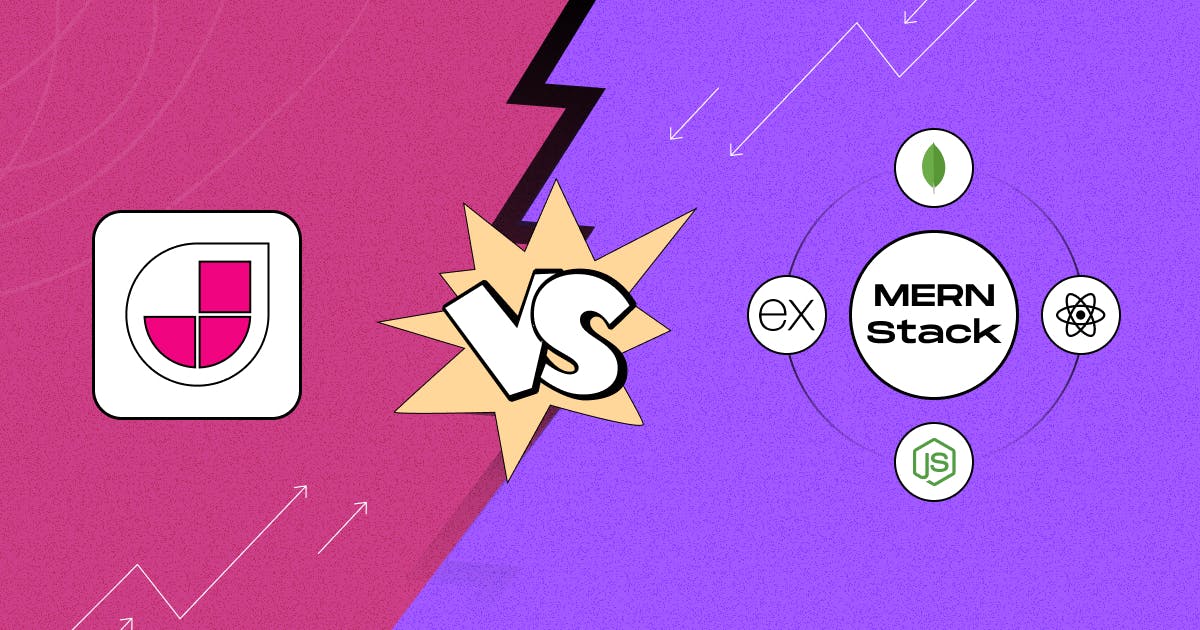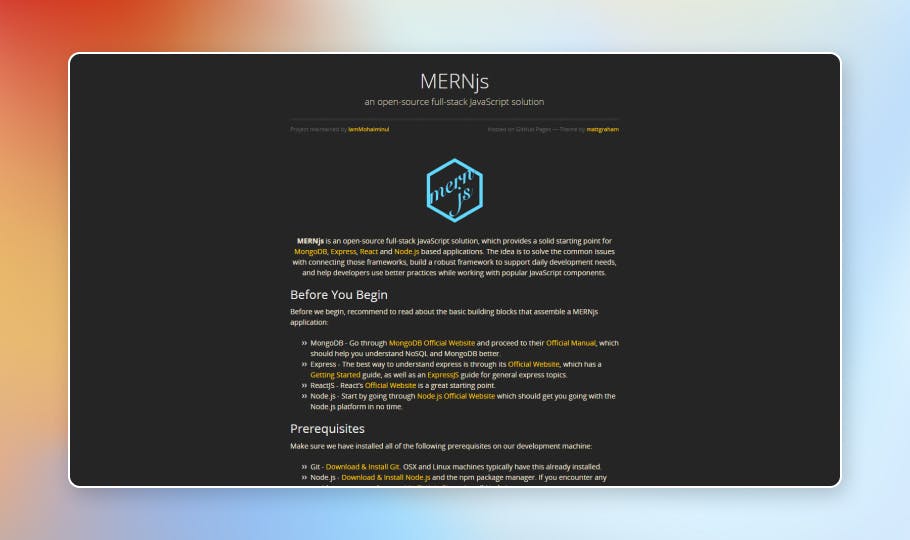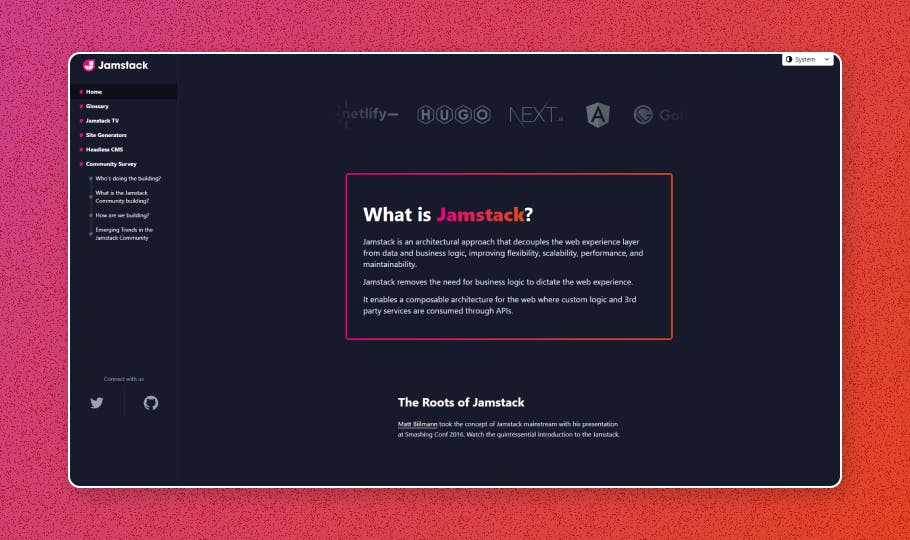October 5, 2023
MERN Stack vs Jamstack

Nusrat Sarmin

In the ever-evolving landscape of web development, making the right architectural choices for your project can significantly impact its success. Two popular approaches that have gained prominence in recent times are MERN and JAMstack. The decision on which one to use depends on your project's requirements and goals. In the long run, the right choice will lead to a successful and efficient web development project.
Let's discover the ultimate showdown: MERN Stack vs JAMstack! Get an insightful comparison that will help you choose the perfect fit for your next big endeavor!
An Overview of the MERN Stack
MERN is an open-source modern web development stack. It is increasingly popular among developers because of its easy-scaling capabilities and high performance.
Simply put, MERN is a full-stack Javascript-based web development solution, encompassing both frontend and backend development. Hence, it's an attractive choice for developers and teams already familiar with JavaScript.

Let's break down the components of MERN:
👉 MongoDB: A popular NoSQL database that offers flexibility in storing data in a JSON-like format.
👉 Express.js: A Node.js web application framework that facilitates server-side development and API creation.
👉 React: A powerful JavaScript library for building dynamic and interactive user interfaces.
👉 Node.js: A JavaScript runtime environment that allows developers to write server-side code in JavaScript.
Pros & Cons of MERN Stack
Pros of MERN Stack:
✔️ Faster Development: Since the MERN stack uses JavaScript for both the front-end (React) and back-end, developers don’t have to switch between multiple languages, which makes the development process faster and more efficient.
✔️ Reusability: React allows for the creation of reusable UI components, saving time and effort in development while leading to cleaner and more maintainable code.
✔️ Real-time Applications: Node.js, with its event-driven architecture, is well-suited for building real-time applications. It is capable of efficiently handling a high volume of concurrent connections.
✔️ Scalability: MongoDB stores data in a flexible and scalable way. It's easy to store and retrieve data, even as the data size grows. Besides, Node.js is capable of handling large amounts of data, making it perfect for scalable web applications.
✔️ Flexible: The MERN stack is highly flexible and allows developers to create complex applications with minimal effort.
✔️ NoSQL Database: MongoDB is a popular NoSQL database that is flexible and can handle unstructured data. It's great for projects with changing data or fast development.
✔️ Easy to learn: The MERN stack is based on JavaScript, which is a language that many developers are already familiar with. This makes it relatively easy to learn and use and cuts down on development time.
✔️ Thriving Ecosystem: MERN boasts a vast and active developer community, ensuring a wealth of resources, libraries, and solutions to common challenges.
Cons of MERN Stack:
❌ Dependency on JavaScript: If your application requires a language other than JavaScript, the MERN stack may not be the best choice.
❌ Limited scalability: While the MERN stack can be used to create complex applications, it may not be able to easily support large-scale applications.
❌ More complexity: Being a full-stack solution, can be more complex compared to using specialized stacks for specific tasks. The management of all four components may become cumbersome for large projects.
❌ SEO Issue: Single-page applications (SPAs) built with React may encounter SEO challenges. Because search engines face difficulty indexing content generated by JavaScript. To tackle this problem, additional steps, like server-side rendering, may be required.
❌ Overhead: MERN applications may experience some overhead due to the various components, particularly if not optimized correctly. This can affect performance and load times if not managed well.
❌ Maintenance: Maintaining the multiple components in the stack requires consistent updates, which can be a challenging and time-consuming task in the long run.
An Overview of JAMStack
JAMStack, on the other hand, is not a specific technology stack. It is a set of principles for building web applications. JAMstack stands for JavaScript, APIs, and Markup. It focuses on separating the front end from the back end.

Let's break down the components of the JAMStack:
👉 JavaScript: While JAMstack does use JavaScript, it mainly focuses on client-side JavaScript for dynamic functionality.
👉 APIs: JAMstack relies on APIs for server-side functionality, data retrieval, and other backend processes. This can include serverless functions, microservices, or traditional RESTful APIs.
👉 Markup: Markup refers to the static HTML content that is pre-generated during the build process and delivered to users via Content Delivery Networks (CDNs).
Pros and Cons of JAMStack
Pros of JAMStack:
✔️ Faster Page Load Times: JAMstack sites serve pre-rendered static content from Content Delivery Networks (CDNs), resulting in faster page load times.
✔️ Improved User Experience: Speedy performance enhances the user experience, reducing bounce rates and improving SEO rankings.
✔️ Reduced Attack Surface: With minimal server-side logic and fewer entry points, JAMstack sites are inherently more secure.
✔️ Scalability: CDNs ensure that JAMstack sites can easily handle traffic spikes and scaling requirements.
✔️ Content Security: The separation of content and code reduces the risk of content-based attacks.
✔️ Simplified Maintenance: Separating the front end and back end simplifies maintenance, updates, and debugging.
✔️ Easy Content Management: Integration with content management systems (CMSs) allows content authors and editors to manage content without needing technical knowledge.
✔️ Developer Experience: Developers can choose the frontend and backend technologies that best suit their project's needs.
Cons of JAMStack:
❌ Complexity for Dynamic Features: Implementing complex, server-heavy features in a JAMstack architecture can be challenging as it may require additional client-side coding and API work.
❌ Initial Learning Curve: Requires learning new tools and technologies. Developers unfamiliar with the JAMstack approach may face a learning curve.
❌ Not Ideal for All Use Cases: It may not be the ideal choice for applications that require extensive server-side processing or complex user interactions.
❌ Dynamic SEO Challenges: SEO optimization for dynamic content (e.g., single-page applications) can be more challenging than traditional server-rendered sites.
❌ Hosting and Maintenance Cost: CDNs are efficient, but they may incur costs, especially for high-traffic sites. Besides, in some cases, you will need the help of a high-paying, qualified developer for maintenance.
❌ Dependency on Third-Party Services: JAMstack projects rely on third-party services, such as APIs and external content sources. If these services go down or change, it can impact your site's functionality.
What Are the Key Differences Between the JAMStack and the MERN Stack?
A side-by-side comparison of MERN Stack vs. JAMStack and highlighting various facets:
| Aspect | MERN Stack | JAMstack |
|---|---|---|
| Technology | MongoDB, Express.js, React, and Node.js | JavaScript, APIs, and Markup |
| Development Architecture | A full-stack solution | Decouple the frontend from the backend |
| Dynamic vs. Static | Applications are more dynamic by default | Static nature by default |
| Server Model | Server-side logic is built directly into the backend | Serverless, Server-side logic is abstracted into APIs |
| Database | MongoDB is the default database | It Doesn’t require a database and relies on external APIs or services for data storage |
| Backend Framework | Express.js is commonly used for building backend APIs | No specific backend framework is required |
| Frontend Framework | React is commonly used for building UI | Use diverse JavaScript frameworks/libraries. |
| Real-time Interactivity | Real-time features often implemented using Web Sockets | Achieved through client-side JavaScript |
| Development Complexity | Involve more complex server-side code and configuration | Can be simpler due to the separation of frontend and backend |
| Scalability | It depends on server infrastructure and database design | Easily scalable |
| Performance | depends on server efficiency and optimization | Usually, offers excellent performance and fast load times |
| SEO | Requires additional SEO optimization | Good SEO due to lightweight pre-rendered content |
| Use cases | Versatile and suitable for real-time applications and projects that require extensive server-side logic | Well-suited for content-centric websites that don't require complex server-side processing. |

LAMP vs. MEAN: Which Stack Is Right For You?
Recap
In summary, MERN Stack and JAMstack are two distinct architectural approaches to web development. MERN is a full-stack solution with a specific set of technologies for both the front end and back end.
On the other hand, JAMstack emphasizes speed, security, and the separation of front-end and back-end. It is not a mix of specific technologies.
In the battle of the MERN Stack vs. JAMstack, both contenders are equally competent. Both are excellent choices, depending on the type of project. Ultimately, the choice between the MERN stack and the JAMstack depends on your project's specific needs, goals, preferences, development skills, budget, etc.
If you need any help, the StaticMania developer team is here to help you. Get in touch to discuss this further. Contact Us!

